Estimated reading time: 8 minutes
Would you love to know how to control aphids in your fruit trees? They are one of the most common pests that infect a variety of fruit trees.
Our experience over meany years has shown that plums in particular are often affected by them. But they can also affect peaches, nectarines, cherries, and even apples and pears.
Do you know how to tell whether you have aphids? We know from getting LOTS of questions from our Grow Great Fruit members that aphids are often confused with leaf curl disease.
First, you need to know how to identify an aphid infection, so let’s start there.
How do you know if you have aphids?
Have you seen any curly leaves like this on your tree? If you have—you’re not alone. It’s a classic sign that you might have aphids.
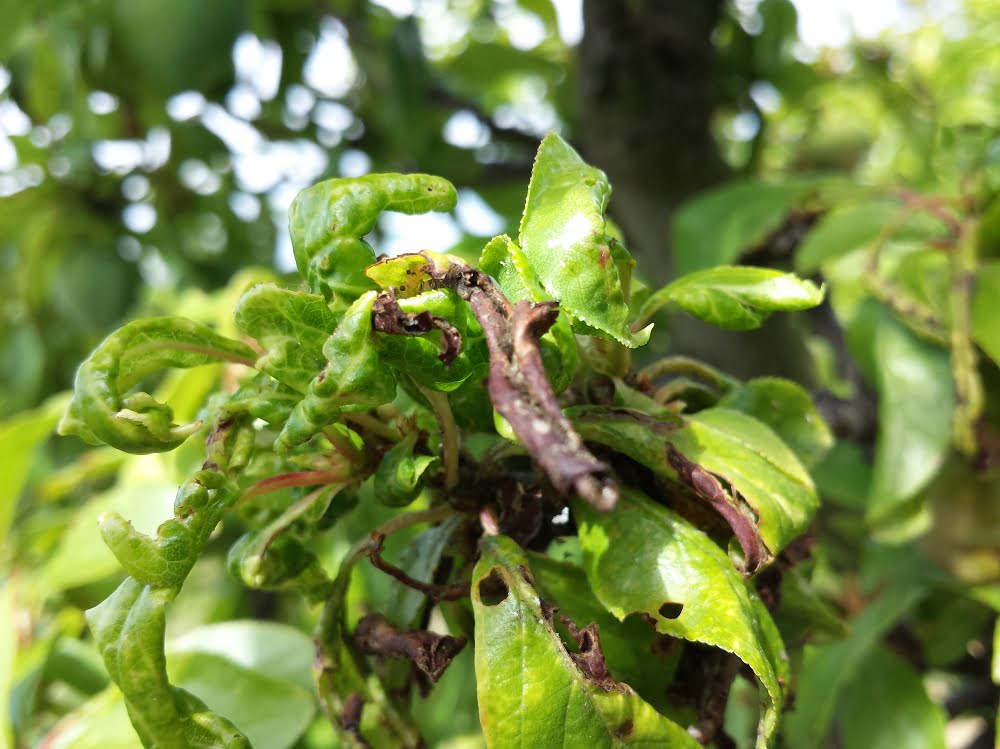
The sap-sucking aphids have taken up residence on the inside of its leaves, which you can see by the curly leaves.
Though it shares the symptom of the leaves going curly, it’s completely different from the Leaf curl disease that you sometimes see on peach and nectarine trees.
If you tease open one of the leaves you’ll usually find aphids of some sort on the inside.
Are aphids easy to spot?
If you get a really bad infestation, you won’t mistake it. You’ll be able to see hundreds (or thousands) of aphids crawling around, as you can see on this peach tree (below).
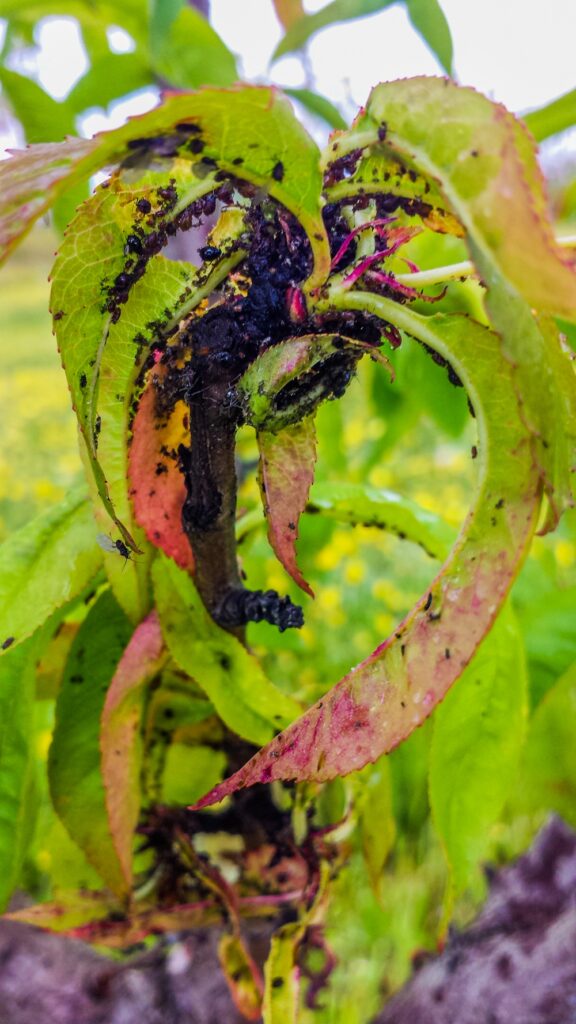
These are black aphids, one of the more common types that infest fruit trees. You’ll often find them on cherry, plum, peach, and nectarine trees.
Another common type on apple trees is called woolly aphid, for a very good reason:
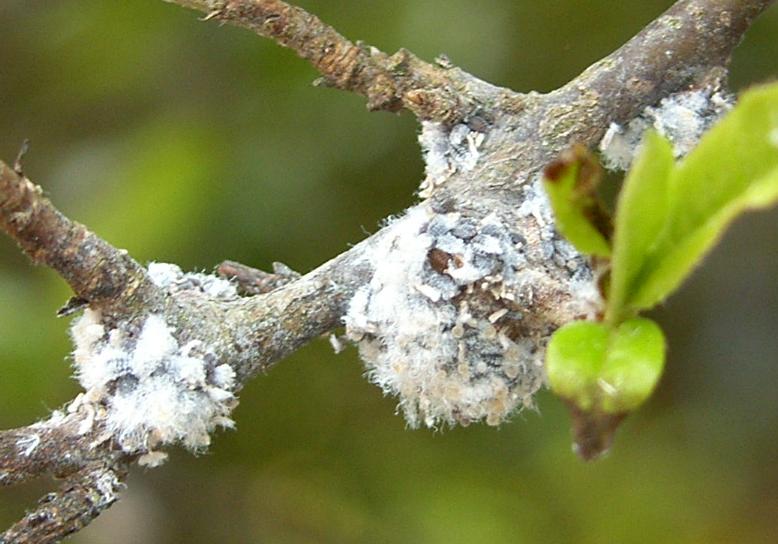
There’s a third type of aphid that commonly affects fruit trees, and that’s green peach aphid, which — you guessed it — you’ll find on peach and nectarine trees.
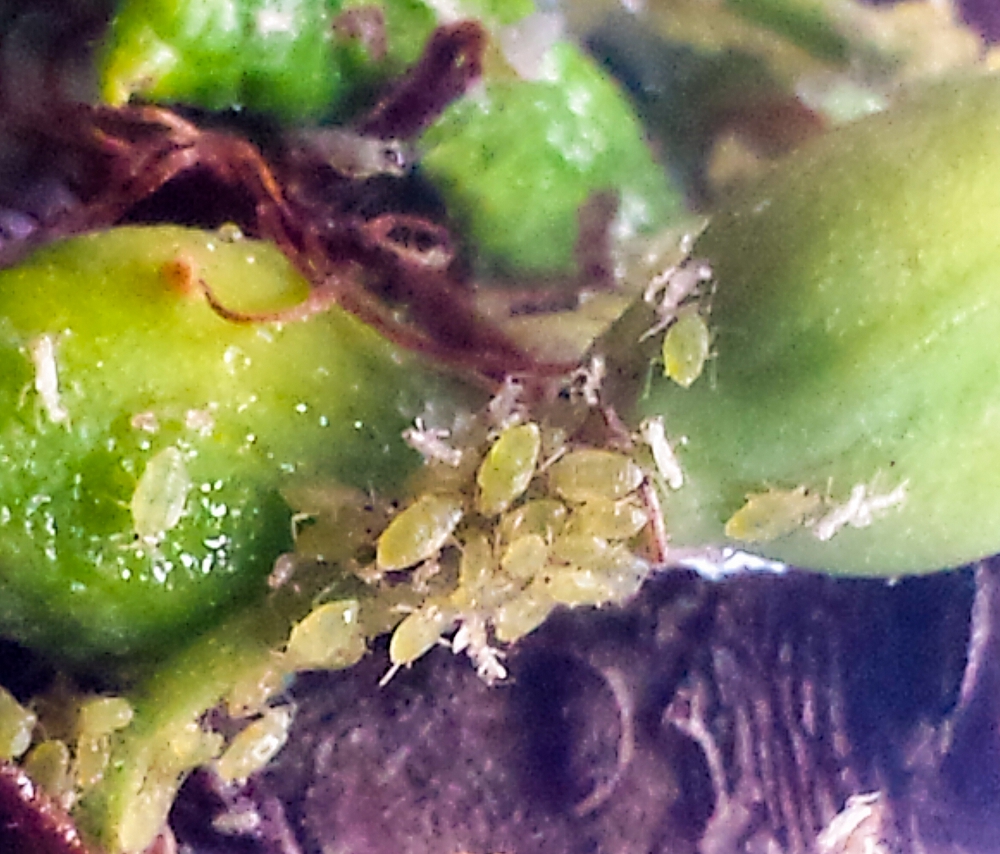
How do you stop an aphid infestation?
The first thing to know is that you don’t have to do it alone!
There are lots of insects that might be in your garden that love to help clean up aphids. Learning how beneficial insects can help your garden is one of the 5 key steps to healthy fruit.
Sometimes when you look inside a curly leaf to see if aphids are responsible, you might see something like this leaf we found on a plum tree:
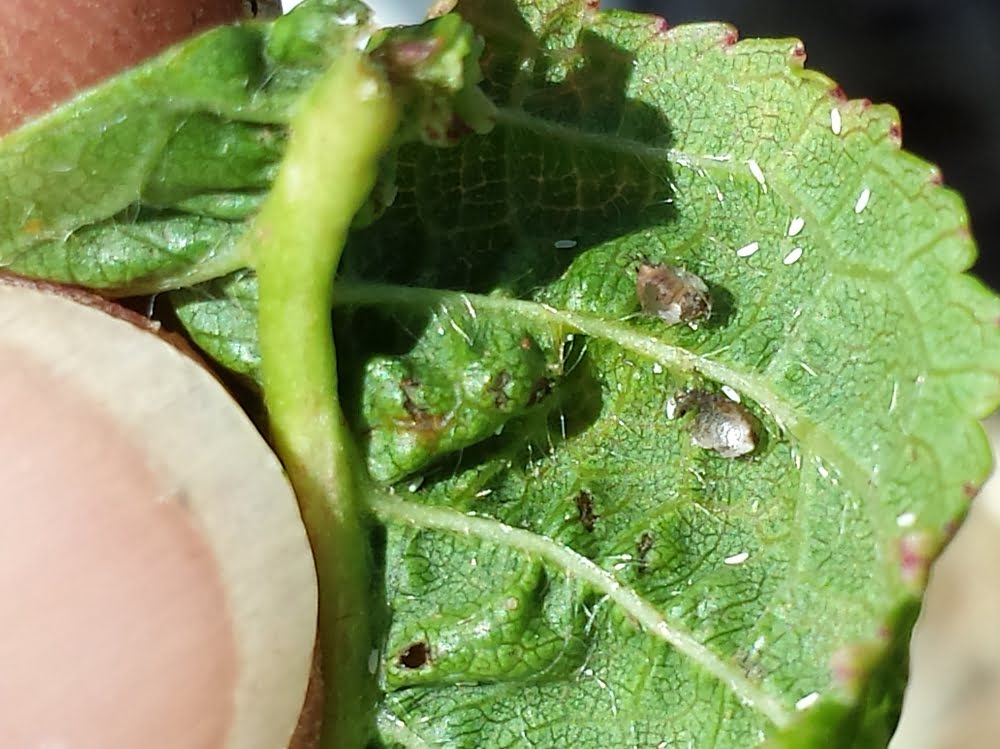
There are only a couple of live aphids here, but those small black smudges are a really good sign. These are the dried and shriveled remains of aphids that have been killed by other insects.
Beneficial insects (that eat other insects) do a wonderful job of keeping pest insects under control in healthy, biodiverse gardens.
Controlling aphids on trees – without using insecticide
We found this leaf (below) on one of our cherry trees. Inside it is a little community of insects that is a great sign of a healthy ecosystem.
A spider and an aphid-eating wasp are co-habiting, and both eat their fill of aphids. (Actually, the spider might be eating the wasp – you can never be sure who’s eating who in the insect world!)
Insecticides (of any sort) are exactly the wrong response for aphids. Using any chemicals will risk destroying the very thing that will fix your problem.
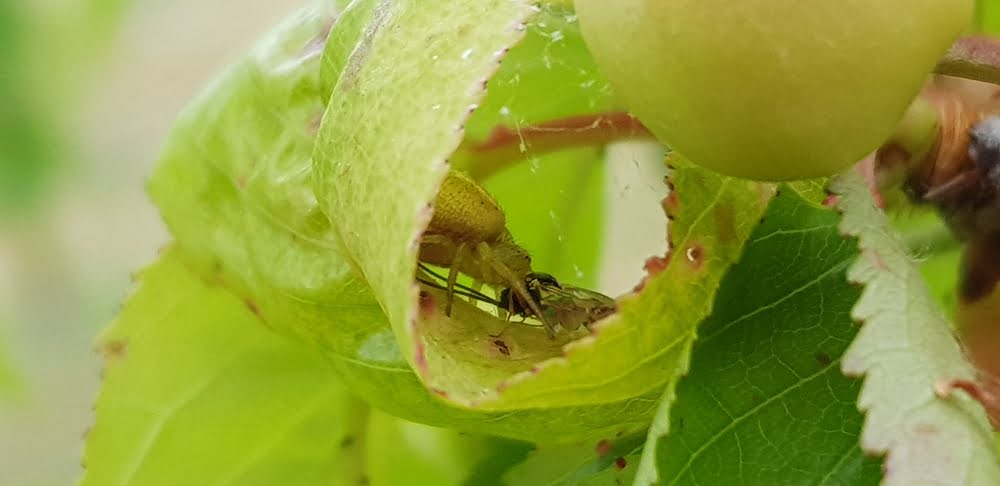
How to get rid of aphids naturally
We’re often asked how to get rid of aphids, and unfortunately, people often aren’t happy with our answer!
Biodiversity and patience really are the keys to getting the populations of these pesky pests back under control.
Whatever you do, DON’T SPRAY INSECTICIDE!
It can feel like an easy solution, but you’ll inevitably kill predator insects and just make the problem worse. Before we converted to organic production, the aphid populations in our orchard stayed high, year after year. It was mainly due to the use of insecticides that routinely kill the “good” insects that would naturally keep the aphids under control.
We learned the hard way that spraying is expensive, it’s ineffective, and it’s bad for the health of the tree, the user, the eater of the fruit, and the whole ecosystem.
In fact, one of the first big successes we had when we stopped using chemicals was seeing green peach aphid and woolly aphid disappear from our orchards almost overnight!
The best homemade aphid killer
We can show you how to make a number of home-made remedies that can help in the short term with aphid control.
However, our experience over many years has shown that just like bought insecticides, if you rely solely on a solution in a bottle you quickly become dependent on needing to use the same solution every year.
In fact, you might even be making the problem worse over time.
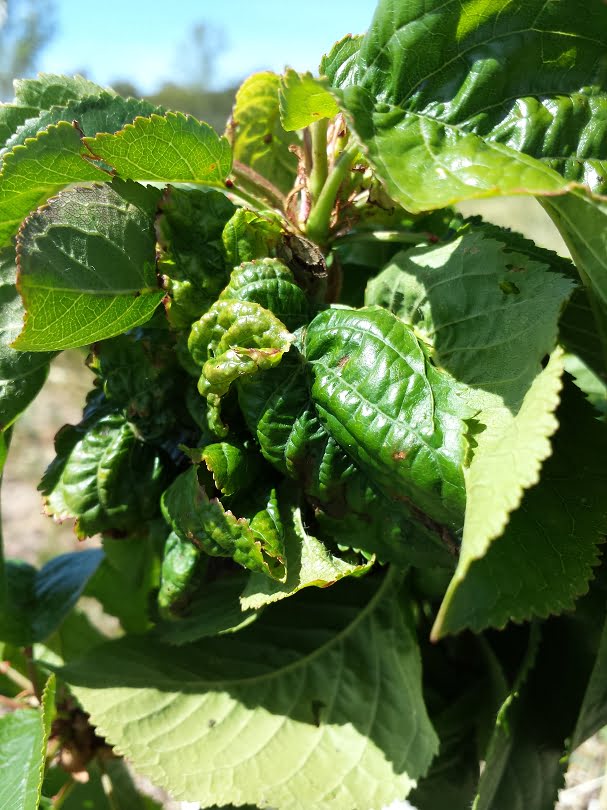
So, here are our top 7 tips for controlling aphids:
- Monitor your trees regularly for aphids.
- If you identify that you do have aphids, watch very carefully to see whether you also have any predator insects around that are eating them. Spiders, ladybirds, and wasps are all particularly voracious aphid-eaters.
- Check whether you have ants in the tree associated with the aphids. Ants like to ‘farm’ aphids by moving them from tree to tree and guarding them against predators.
- If you find ants in your trees, exclude them by any means necessary. Don’t bother trying to kill the ants as they bring excellent eco-services to your garden and are very hard to get rid of. Stop them from getting to the aphids by putting a sticky barrier between the aphids and the ant nest.
- Focus on building the biodiversity of plant life under your fruit trees. Flowering plants, particularly white and yellow flowers are really good at attracting predator insects and providing them with habitat.
- Unhealthy trees will attract more aphids, so concentrate on improving the health of your tree by improving the soil it’s growing in.
- Use short-term solutions (like organic sprays) only in extreme circumstances, and with extreme caution!
We recommend keeping a toolbox of short term solutions in your back pocket, but taking a more long-term view by creating such a healthy garden that aphid populations are kept under control naturally.
Related Articles
What broke my fruit tree?
Broken fruit trees can be caused by animals eating them, or accidental damage. Identifying the animal is the first step to prevention.
How to review and improve your fruit tree netting
Ineffective netting over your fruit trees may be costing you more than you think, so review your netting at the end of the season.
6 Steps to Looking After Fruit Fly and Bird Nets
Fruit fly and bird nets are key to your fruit growing success. These 6 simple steps to look after them properly will help them last longer.

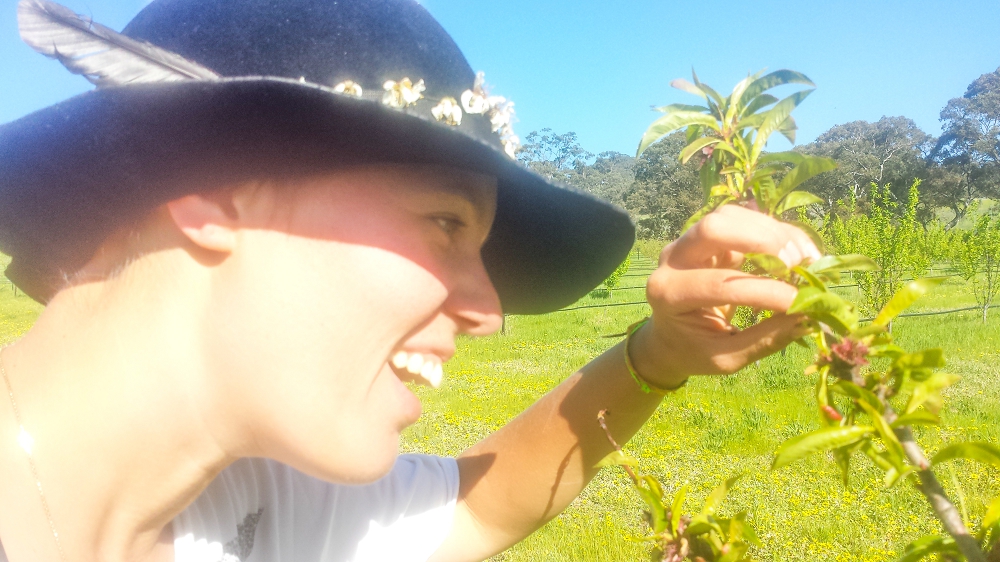


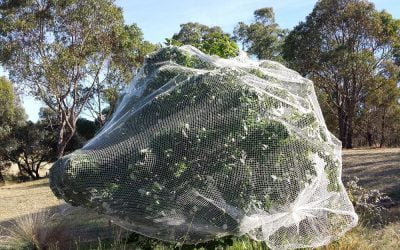
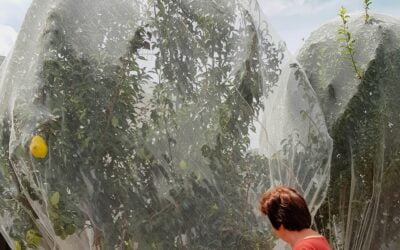


I buy a predator for them and it works very well.They are not cheap but the results are good and you don’t have to spray.I bought some three years ago and I have not had anymore trouble until this year .I have bought some more about a month ago and they are doing a good job.I have even given some plant material to friends to put on their garden to tackle the problem.They are a long term solution not a quick fix.
Don.
Hi Don, thanks for sharing your experience. Buying in predators is another option for sure, but expensive as you say. Your experience that the bought-in bugs don’t always stick around but need replacing is similar to what we’ve heard from other gardeners as well, which further adds to the cost!
I have an apple and this is the first year it has bloomed and has apples but is smothered with blackfly a lot of leaves are curled very tightly. Should I remove the curled leaves?
What were the predictor you bought please, we live in south australia
Would Neem oil be considered ok? I don’t THINK it kills other bugs but not 100% certain
Hi Pam, Neem oil can be a tricky one – some of the ‘over the counter’ versions of Neem products can indeed be harmful to a range of insects including bees (always read the label, in depth!). The active compounds in neem can also be pretty intense for human systems, so even though Neem can be ‘naturally derived’ it doesn’t mean it’s not risky. It can be a good option if there is a really big problem though. Meg – GGF team.
I have a productive apricot tree in the backyard, and every year I notice ladybirds on the fruit as I pick it. I can only guess that the ‘Apricot ecosystem’ has reached a balance of some sort. The apricots are nearly all in good condition, with minimal damage from earwigs or other pests.
The fruit is always thinned very hard, which also helps with pests and diseases, and produces larger, sweeter apricots.
Hi Ian, what a great story, thanks for sharing, and well done on your beautiful crop. We couldn’t agree more about the thinning, it makes a big difference to the crop. Enjoy this year’s apricots.
Thank you for this very informative post. I thought my peach and nectarine had curly leaf disease and then discovered some perennials had it too. Then I found the quince had it…. and now I might have discovered the answer……
Our pleasure Edith, glad we’ve helped you get to the bottom of the problem
Excellent to hear Edith, glad we’ve helped you get to the bottom of the problem.
Hello,
The information you have shared regarding beneficial insects is very true.
I have also found that nutrient balance is a very important factor in pest control,as is the timing and type of “fertiliser” applied.
Typically we were taught to fertilise in spring which encourages plenty of lush green growth which aphids and other sap sucking insects love!
I found that applying the required slow release organic based fertiliser in Autumn gives time for the microbes to “process” the nutrients into more stable forms and provide the nutrients over a longer period and without the big sappy flush of new growth in spring.
Balancing ammonium and nitrate Nitrogen 1:1 in the soil solution is also important for the above reasons.
Ultimately, soil testing is a must and really should happen before any fertiliser/compost is applied to ensure you are giving your plants the correct chemistry that they require for good health and fruit production.
Thanks for the comment Ben, and great point, soil chemistry is definitely an important factor. We don’t routinely recommend soil testing for backyard growers – you can read more about our ‘slow burn’ (and affordable) soil improvement approach here if you’re interested https://growgreatfruit.com/have-you-planted-a-green-manure-crop-this-year/
Hi Ben, thanks for the comment. Yes, totally agree that nutrition is also very important for pest control. We don’t recommend routine soil testing for backyard growers though, it can be very expensive and is usually unnecessary if you just pursue a continuous soil improvement program, adding a diversity of inputs (like compost) from different sources. Most nutritional issues will sort themselves right out!
When do you thin apricots?
Hi Chris – we’ve written a blog on that very topic, well several actually, but here’s the first one to get started with: https://growgreatfruit.com/thinning-101/
Where do I buy predators from ?
Hi Eddie, the best way is to attract predators naturally to your garden by building up biodiversity – aim to grow as many different types of plants as possible, with a focus on flowering plants. Having plants that are green and growing all year, and having flowering plants throughout as much of the year as possible are the goals. Biodiversity can include trees, shrubs, understorey plants, animals, birds, water sources, microclimates, etc. In the meantime, while you’re establishing your paradise, there are a few companies that sell predators, but we haven’t worked with any of them so can’t recommend any in particular. The feedback we regularly get from people is that bought predators may help a little, but need to be bought in again each year, so it can get pretty expensive.
I want to try planting apples am in kenya
In regard to black aphids on cherry trees, I have had them very bad last 2 years but the fruit crop is still quite good. The aphids seem to attack and congregate on the leaf tips so I pinched off all the curly leaf tips and disposed of them and in the fruiting period they didn’t come back .
Sounds like you’ve got a great method to keep the population in balance – nice work! Meg – Grow Great Fruit team.
Does aphid infestation affect fruit production. I have an infestation of the green peach aphids on my peach tree, but also have a bumper crop of fruit. I have eliminated the ants with a sticky barrier. I’m just hoping my fruit will continue to ripen.
Look, if an infestation is really bad, it can effect fruit. Usually, there are a couple of possibilities:
1. aphids suck sap, so can reduce overall vigour and lead to early fruit ripening.
2. their honeydew can lead to sooty mould on fruit
3. transmitting viruses that might effect fruiting.
But, if you have a bumper crop and they’re looking good, we wouldn’t be too worried – and would focus on the general treatments to keep populations in balance which you’ve already done. Stopping them being farmed by the ants is a great step to keep their population in check! Hope you get to eat those peaches, Meg – Grow Great Fruit team.
I have 2 plum trees with leaf curl l have sprayed while dormant and right up to bud l have heaps of fruit but it’s now dropping l can’t see any active bugs but everything l read suggests plum aphids any suggestions would be much appreciated l really want to save some fruit this year
Hi Kylie – sounds annoying! You might find this blog helpful as well. If you can’t see any aphids it may be something else (e.g. could be waterlogging depending on how exactly the leaves are ‘curling’). Good luck, Meg – GGF team.
In my orchard I have a Kentish cherry and a Morello cherry. The Kentish produces a ton of fruit, looks great and some years gets an attack of cherry slug. When they appear I spray the whole tree with water then I fling cold wood ash from the fire, over the tree. It sticks to the water on the leaves and the cherry slugs. The slugs die. The next rain everything washes off. The Morello gets really bad black aphid. This trick won’t work on aphids. I’ve simply cut off the curled leaves and left them in a sealed black bag in the sun. But the tree remains susceptible. Why this tree only? What can I grow underneath/nearby? I am trying Yellow flowering nasturtiums as an experiment this year any other suggestions?
It’s interesting that they are attracted to that tree. Sounds like you are practicing the art of observing your fruit trees closely, which is great. Do you find the Morello has a smaller crop because of the aphids? If they aren’t effecting your crop, whilst unsightly there might not be a problem to solve (often other critters will solve the problem for us if we let them!).
Understory plants that attract predatory insects can be a great long term solution. Nasturtiums are a fantastic choice, plants with an ‘umbel’ kind of flower arrangement – so fennel, dill, coriander, achilleas – all attract predatory insects like lady beetles. In the short term, you might want to check what else is going on in particular for that tree. Is there anything different about the water, soil or microclimate for that tree? Aphids can be attracted to lots of tender green growth (so, moisture & high nitrogen can contribute). Good luck & report back! Meg – GGF team.
We have two cherry trees so close to each other that the branches touch. One is under heavy black aphid attack every season. The other one – not an aphid on it. Does not seem to make sense but the observation is most reliable. What makes the difference? Does not make sense at the first glance.
Hello everyone,
I have a peach tree, that is infected with something. The leaves are curled and black/brownish. I am now using Lemon dishwashing liquid to see what happens. I will keep you posted on the results.
Thanks,
Cynthia
Hi Cynthia,
If this occurred early in the season, it sounds loike leaf curl – the treatment for which is to spray with copper (eg, Kocide) very early in spring at the first sign of buds swelling, then follow that up 7-10 days later with a second copper spray. That’s it. If you miss these sprays and find you have leaf curl, it is too late to do anything about it until next spring. The trees will grow through the leaf curl as the weather warms up, and the diseased leaves will shrivel up and fall off.
Black leaf tips on young grwoth later in the season may well be frost.
Hope that helps.